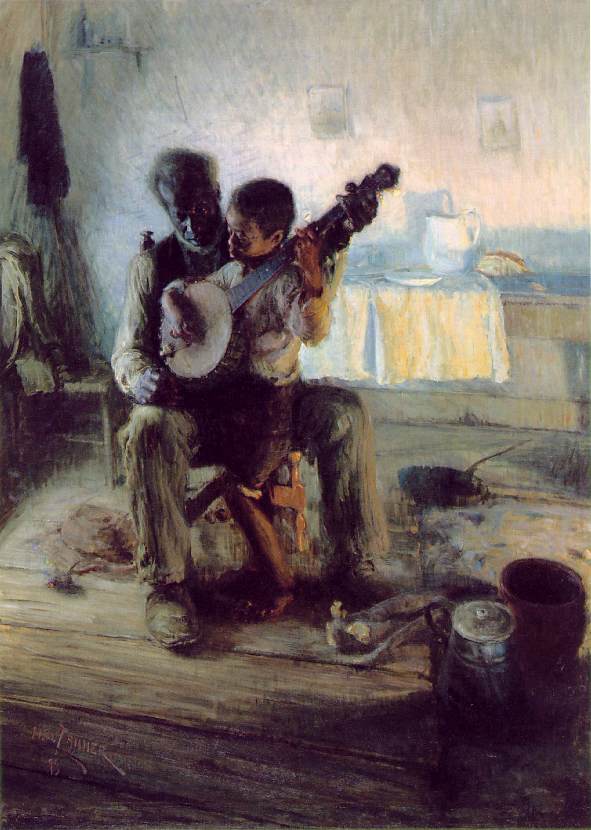SUMMARY
The third installment in our blog series exploring the ways artists have responded to crisis, we take a look at artworks of Mary Edmonia Lewis and Henry Ossawa Tanner.
The third installment in our blog series exploring the ways artists have responded to crisis, we take a look at artworks of Mary Edmonia Lewis and Henry Ossawa Tanner.
Making art is extremely difficult
artist Carrie Mae Weems, the only Black woman to have a retrospective at the Guggenheim Museum, has said. It requires tremendous courage, enormous sacrifice, [and] great risk
. [i] Courage, sacrifice and risk defined two of the leading African American artists of the 19th century, Mary Edmonia Lewis (ca. 1845-1907) and Henry Ossawa Tanner (1859-1937). Lewis, one of the leading sculptors of the neoclassical style, and Tanner, a renowned genre and religious-subject painter, rose to significant international acclaim.
Yet each endured great struggle because of their race, and in Lewis’ case her gender as well. Their stories remain significant and pointedly relevant for us today as we reckon with racism and the systemic injustices it wields, particularly against Blacks and People of Color.
Mary Edmonia Lewis redefined the 19th century’s conception of a sculptor as white and male. Born to an African American father and a Native American (Chippewa) mother, Lewis attended Oberlin College in Ohio, a major abolitionist center that admitted women and African Americans. Showing artistic promise, her studies were cut short when she was falsely accused of having poisoned two white classmates.
Shortly before the ensuing trial, she was brutally attacked. Although she recovered physically and was exonerated of all charges, she continued to be the object of fabricated accusations and was barred from graduation. Deeply traumatized by these events, Lewis nonetheless determined to become a sculptor. She ultimately settled in Rome, where she honed her sculptural skills in the land of Classical Roman and Renaissance art.
There she enjoyed a greater degree of cultural freedom, and although she was still subjected to racism – some prospective buyers of her art, for example, insisted on watching her work as they could not believe a Black woman was capable – she also achieved critical and international success, while always promoting herself on her own terms.
Lewis produced numerous portraits, but she was most celebrated for her marble sculptural groupings that directly addressed issues related to race and gender, including Forever Free [1867; Howard University], a work that celebrates the Emancipation Proclamation issued by Abraham Lincoln in 1863. A man stands with his arm lifted, broken shackles around his wrist and chains at his feet, while at his side a woman kneels on one knee with her hands clasped in prayer.
Both figures gaze upward and Lewis suggests we are seeing the moment just following emancipation. Lewis’s Native American heritage inspired her interpretation of Henry Wadsworth Longfellow’s epic poem The Song of Hiawatha (1855), including The Old Arrow Maker and His Daughter [1866; Smithsonian American Art Museum]. In multiple interpretations of the poem, Lewis classicized the figures’ facial features but she brought much greater realism to their clothing and accoutrements based on her first-hand knowledge; Wadsworth’s Hiawatha descended from the same tribe as Lewis.
Like Lewis, Henry Ossawa Tanner relocated to Europe, leaving his home in Philadelphia for Paris in the 1890s to escape the rampant racism he experienced. In one episode while he was a student at the Pennsylvania Academy of Fine Arts, he was dragged out to the street by a group of white classmates, tied to an easel in a mock crucifixion and left struggling.
Once in Paris, Tanner became a major success and was considered the premier biblical painter of his day. His focus on religious subjects was influenced by his parents – his mother had been born into slavery and his father was a Bishop in the AME Church.
They maintained a home that was a prominent intellectual center for the Black community of Philadelphia and ensured that faith and prayer and black culture and scholarship underpinned Tanner’s upbringing.
One of Tanner’s most famous biblical subjects was The Annunciation [1898; Philadelphia Museum of Art], which reveals his sensitivity to the young subject of Mary being visited by the Archangel Gabriel, here portrayed as pure light. Tanner treated his traditional subjects in a decidedly modernist fashion, experimenting with different kinds of glazes (thin, transparent coats of paint) using oil and tempera, which resulted in evocative surfaces that seem to be illuminated from within.
Following a bout with typhoid, Tanner returned home to Philadelphia, and during his time he undertook subjects like The Banjo Lesson [1893; Hampton University Museum], in which he underscored the dignity and individuality of African Americans.
By monumentalizing the relationship between a grandfather and his grandson, Tanner elevated the Black subject to the realm of high art, uprooting the tradition of derogatory imagery that was common in the 19th century.
Although Tanner did not depict Black subjects in his work after this period, racial issues remained close to his heart; he championed African-American rights and provided guidance to younger generations of black artists throughout his career.

Courage, sacrifice and risk. Lewis and Tanner lived, sculpted and painted these words.
Read the previous installment in this art series, Artists in Isolation.
Through our Art Advisory service, we can guide you through the art market, developing an acquisition strategy to build a collection that reflects your vision.

To help put you in touch with the right Private Bank team, please answer the following questions.